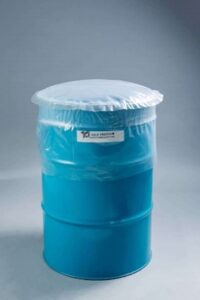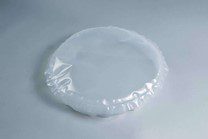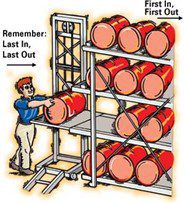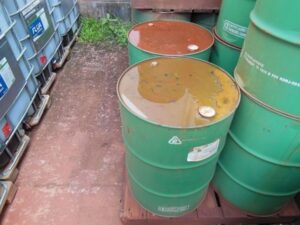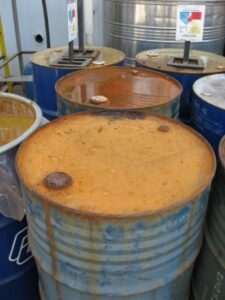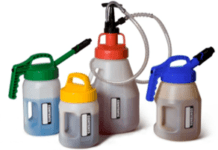
Marcos Thadeu Lobo
Mechanical Engineer Graduated from the State University of Campinas (Unicamp). He currently works as an Associate Consultant at the company QU4TTUOR CONSULTORIA.
Drum storage
Drum storage – Due to the limited space in internal areas of industrial plants and mobile equipment maintenance sites, it is common to use open-air areas for receiving and storing lubricating oil drums, thus raising the the risk of ingress of water and abrasive solid particulate matter if storage conditions are not adequate.
 Figure 1 – Storage in external areas: risk of contamination
Figure 1 – Storage in external areas: risk of contamination
Storage of lubricating oil drums in open areas is of particular concern during the summer months, when temperatures on the metallic surfaces of the reservoirs can be above 70°C.
 Figure 2 – Open-air storage during the summer: worrying
Figure 2 – Open-air storage during the summer: worrying
In the rainy season, water can accumulate on the lubricating oil drum covers and submerge the plugs (2” and 3/4” ). As the temperature of the lubricating oil drums rises at dawn and during the day, decreasing in the late afternoon and at night, the so-called “drum breathing” process takes place.
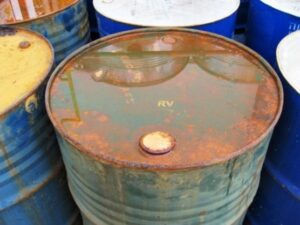
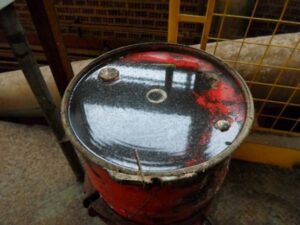 Figures 3/4 – Water accumulated in lids: “drum breathing”
Figures 3/4 – Water accumulated in lids: “drum breathing”
The air in the free space between the drum cover and the lubricating oil surface is exhaled to the atmosphere when the lubricating oil mass temperature rises and inhaled when the lubricating oil mass temperature decreases. If there is water accumulated in the lubricating oil drums lids and the plugs (2” and 3/4”) are submerged, the process of inhalation of water and abrasive solid particulate material will occur, a process in which the water and dirt accumulated in the drum lid of lubricating oil is sucked into the drum, contaminating the lubricating oil mass with water and abrasive solid particulate material. This process can occur in unused, sealed lubricating oil drums.
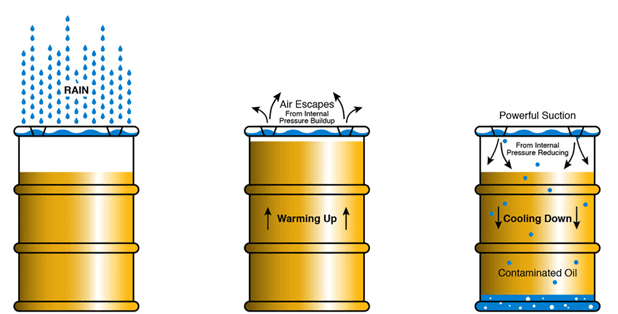 Figure 5 – “Drum breathing” of lubricant
Figure 5 – “Drum breathing” of lubricant
The water and dirt inhaled into the lubricating oil drums will be deposited at the bottom of the reservoirs, with a rise in the lubricating oil level. As the process continues, more water and dirt will accumulate at the bottom of the lubricating oil drums, deforming them and causing the lubricating oil to overflow through the plugs (2” and 3/4”).
Figures 6/7 – The oil level rises through the water tank at the bottom
This problem can be mitigated by some very simple and inexpensive solutions. When storage of lubricating oil drums in the open is unavoidable, they should be stored horizontally and covered. There is a wide variety of pallets and easels available on the market for this purpose. If it is not possible to use pallets or easels, you can simply place wooden pallets under the reinforcing metal rings of the lubricating oil drums so that the plugs (2” and 3/4” ) are in the positions 3 – 9, as illustrated by the hands of a clock.
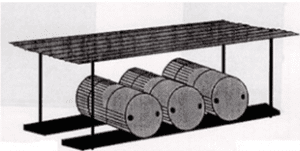
 Figures 8/9 – Covered drums, on pallets and in position 3 – 9
Figures 8/9 – Covered drums, on pallets and in position 3 – 9
Storing lubricating oil drums in position 3 – 9 will prevent water and dirt from accumulating on the cover and being inhaled into the lubricating oil mass when “drum breathing”. Flexible plastic covers with elastic edges can also be purchased to prevent water and dirt from accumulating on the lube oil drum covers, preventing contamination of the lubricating oil mass by inhalation.
Figures 10/11 – Flexible covers: lubricating oil drum covers
Another possible solution for use in the storage of lubricating oil drums in open areas is the use of modular easels properly designed for this purpose, with a wide variety of such equipment available on the market.
Figures 12/13 – Modular easels for drum storage
When storing lubricating oils in open areas, it is very important to adopt the “PEPS – FIRST IN, FIRST OUT” methodology. It is suggested to store the least number of lubricating oil drums reasonably possible in order to increase their turnover and reduce the risk of degradation and contamination of the lubricating oil.
Figures 14/15 – Methodology “PEPS – FIRST IN, FIRST OUT” and disappearance of the original drum identification.
Although often overlooked, the storage of lube oil drums can have a major effect on the in-service condition of the lubricating oil before it is put into operation. It is important to remember that to achieve maximum efficiency, the lubricating oil must be clean, dry and cool.
Figures 16/17 – Lubricating oil Drum storage: clean, dry and cold







